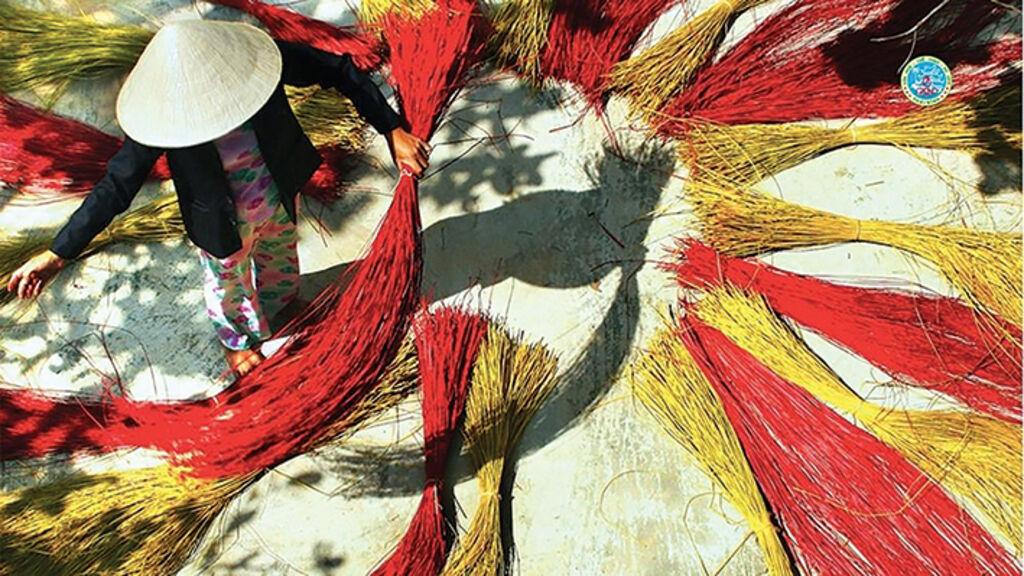 Caption: Sedge threads and jute fibers are dyed and sun-dried__Photo: Thai Binh Department of Culture, Sports and Tourism
Caption: Sedge threads and jute fibers are dyed and sun-dried__Photo: Thai Binh Department of Culture, Sports and TourismAccording to old villagers, the mat weaving craft in Hoi village can be traced back to the Early Le-Ly dynasties in the 10th-11th centuries and grew strong in the Later Le dynasty in the 15th century. In the initial stage, due to technical limitations, products of Hoi village had not been of the high quality that they were in subsequent times. In 1481, Pham Don Le, a young scholar from Tan Hung district (now Hung Ha district) became the First Doctoral Candidate in the royal exam. He was later sent by King Le Thanh Tong to China as the King’s envoy. During his trip in the neighboring country, he learnt special mat-weaving techniques from local people and passed them down to Hoi villagers when he returned to his homeland. From this time on, the quality of mats produced by Hoi villagers was much improved and the village started to be well-known for the mat-weaving craft. Today, it is believed that the mat-weaving craft had originated from Hoi village and spread out across the country since that time. After Pham Don Le passed away, Hoi villagers divinized him as the ancestor of the mat-weaving craft and built a temple to worship him.
To make a beautiful mat, selected sedge threads must be thin, white and round__Photo: laodong.vnWith its geographical advantages, lying between the Red River and the Luoc River, Hoi village is an ideal land area for growing sedge and jute plants, the major raw materials for making mats.
 A mat maker cuts redundant sedge threads__Photo: laodong.vn
A mat maker cuts redundant sedge threads__Photo: laodong.vnAfter being harvested, sedge or jute threads will go through multi-step processing, from the selection of materials to drying, dyeing, and finally weaving. “In order to produce high-quality mats, it is a must to select white round sedge threads,” Nguyen Thi Xoa, a mat maker in Hoi village told the reporter.
The selected sedge or jute threads will be then dyed before weaved. The color of sedge threads or jute threads will depend on the type of the mat to be woven. To be able to weave a delicate mat, a weaver must possess a skillful hand, extensive experience and creative techniques.
 Hoi mats vary in decorative pattern and size__Photo: Thai Binh Department of Culture, Sports and Tourism
Hoi mats vary in decorative pattern and size__Photo: Thai Binh Department of Culture, Sports and TourismThe following steps are hemming mat edges and cutting redundant sedge threads. For printed mats, after finishing the printing step, a mat will be sun-dried for two hours and then put into a boiler for steaming to make the color adhere tightly to the surface of the mat and not fade off.
Hoi village’s mats vary in pattern, weaving technique, and size. Some are flower-patterned, others plain. Some are single-woven, others twine.
 Hoi villagers now use mechanical looms to make more durable and even mats and save time__Photo: laodong.vn
Hoi villagers now use mechanical looms to make more durable and even mats and save time__Photo: laodong.vnThe village has more than 3,000 households, with over 80 percent of them engaged in mat weaving. Villagers often reserve eight months every year to weave mats and spend the remaining time for field work. Weaving mats manually requires craftsmen to spend a lot of effort and time. In the past, a person can only weave one or two pieces a day. Nowsdays, with mechanical looms and other modern machines, a person can produce up to 40 pieces a day.
At present, despite the appearance in the market of other types of mats such as plastic and bamboo mats, mats made of sedge jute threads are still widely used by people because they are very cool and airy in hot summer days. Sedge and jute mats from Hoi village are sold to all regions nationwide and became familiar to every Vietnamese family.-



